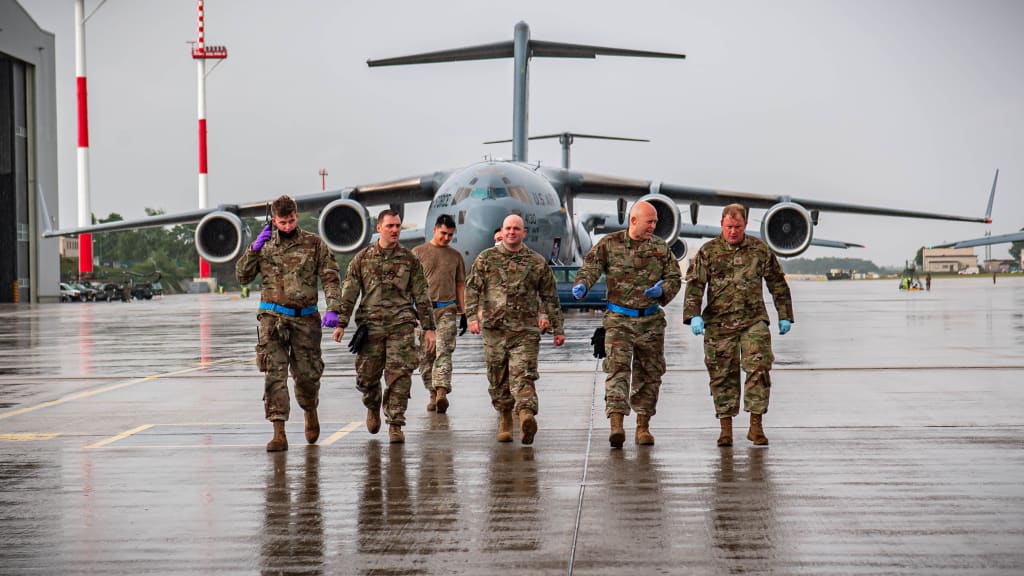
January 20th (Ramstein Air Base, Germany) – The United States of America has not declared war on anyone since June 4, 1942 when Congress made such a statement against Axis partners Bulgaria, Hungary, and Romania during World War II.
To anyone born after that point, this may come as quite a surprise. After all, the United States has been involved in armed conflicts in Korea, Vietnam, Iraq, Afghanistan, and many other locales all over the world since then. Despite this, in every confrontation since the end of World War II, the ability to do so has either come from a specific resolution passed by Congress or by the President acting in a unilateral manner using funds allocated for general military purposes. No official wars have been declared.
The Constitution clearly outlines that only Congress can declare war and maintain the necessary monies and forces to do so (Article 1 § Section 8 § Clauses 11 to 16). Similarly, recorded discussions between the Founding Fathers while writing the Constitution highlight that their wording gives the President “the power to repel sudden attacks.” Coupling that conversation with interpretations of a component that calls for the Executive Branch to protect States from invasion or domestic violence when Congress is unavailable (Article 4 § Section 4) seemingly has given the President limited capabilities to respond in an emergency situation. Yet, the definition of an “emergency” and the lack of engagement by Congress to rein in the President has led to a de facto shift in control.
While discussing Congress’s abdication of its power and responsibility over armed conflict, Elizabeth Goitein of the left-leaning Brennan Center for Justice stated in January 2020 (https://www.brennancenter.org/our-work/research-reports/congresss-role-military-conflict-growing-gap-between-constitutional):
The 2001 AUMF authorized the use of military force against “those nations, organizations, or persons who [the president] determines planned, authorized, committed, or aided the terrorist attacks that occurred on September 11, 2001, or harbored such organizations or persons.” Eighteen years later, this law has been invoked 37 times to support conflicts occurring in 14 different countries, against organizations that did not even exist on 9/11.
As also laid out by Ms. Goitein, this clout has been used by successive administrations, Republican and Democratic alike. Prior to the existence of this specific legislation, Presidents used other means available to them or just plain ignored Congress in its entirety in order to deploy troops where they deemed necessary. There were occasions when the President at that time did not inform Congress and the Legislative Branch only found out through investigations. On other occasions, Congress explicitly forbade such actions, but the President refused to comply. In all of these circumstances, though—and again no matter the Political Party of the President—Congress refused to impeach and remove the President; thus, this behavior has been tacitly allowed and approved.
Apparently, since Congress has continually rebuffed taking back their Constitutionally mandated duty, the new President has decided to do it for them.
During the Inauguration Ceremony, the President ended the celebrations early and began to immediately sign a set of Executive Orders. The President had already made moves that were questionably within the purview of the Executive Branch’s powers, most notably shutting down Guantanamo Bay, massively disarming the country’s nuclear arsenal, and dismantling the United Nations. Each of these actions were seen by even the President’s most zealous supporters as, at the very least, destabilizing. With this sixth Executive Order, the President has built upon that theme and angered allies all over the world, most notably in NATO. As the President told the still-reeling crowd:
From this point forward, American soldiers will not be deployed anywhere in the world without a direct declaration of war or a specific resolution by Congress. Since Congress has not had the courage to do so, I will pull back powers from the Executive Branch that it never should have had in the first place, and return our country to our Constitutionally mandated balance.
While one part of the Executive Order did cover future situations in which the President pledged to make this a reality, the real issue lies in the fact that over 20% of the nearly 1.5 million U.S. troops are deployed elsewhere in the world. These numbers have ramped up over the years, especially in Europe after Russia’s invasion of Ukraine in 2022 and around China and North Korea as the communist partners have increased pressure on American allies in their general vicinity. Specifically, the United States maintains around 750 military bases outside of the U.S. and its territories, not including boats, submarines, and comparable transports sitting in international waters.
Similar to plans for Guantanamo Bay, the President decreed that the United States should withdraw from everywhere outside its own territories unless—as noted before—Congress has passed or will pass legislation to keep a presence there. As such, the President ordered a review of every current mission, base, mass deployment (no matter whether for conflict or humanitarian reasons), and all other military-related matters to be completed within 180 days.
One of the key areas the President has turned to is the Constitution itself, which says that Congress has the ability to (Article 1 § Section 8 § Clause 12):
[R]aise and support Armies, but no Appropriation of Money... shall be for a longer Term than two Years;
Within that review, the President has said that each mission must be tied to a specific resolution from Congress passed within the past two years. General resolutions will not count, nor will a specific resolution that is more than two years old. This part of the order has already led to great consternations and questions. For instance, although Japan hosts the largest number of American troops outside of home soil, decisions on deployment levels are determined largely by the Executive Branch and military divisions themselves. The National Defense Authorization Act as passed by Congress on a near-annual basis does outline specific funding for the maintenance and construction of bases located in Japan. Further, a section of the act calls for “enhancing cooperation with Japan, consistent with the Treaty of Mutual Cooperation and Security [b]etween the United States of America and Japan, including by developing advanced military capabilities, fostering interoperability across all domains, and improving sharing of information and intelligence...” Yet nowhere in the text is an appropriation for a named mission to Japan explicitly made, nor any timeframes declared. Due to this, the President’s orders would seem to indicate that the personnel and equipment in Japan must be returned home. When asked about examples like this aboard Air Force One, the President told the press corps:
The answer is simple. If Congress wants our troops to be somewhere, they can declare war or pass a resolution specific for that deployment. I will not, until the end of this fiscal year, veto anything they send me and will take them as orders. If Congress does not do that, then I have no choice but to bring our servicepeople home.
How to move hundreds of thousands of troops home very suddenly is a largely open question. As part of the 180-day review, each commander is to create a withdrawal plan. Even if the commander finds reason to believe their mission is valid as the President has defined it, they are still to create a complete extraction stratagem that will ensure no U.S. personnel, equipment, or buildings and materials are left behind.
Unlike with Guantanamo Bay, though, there is no immediate call to implement each of these retreats. Instead, the President will be reviewing every report and overall proposal to determine which missions need to be wrapped up and when that is to happen. The only requirement is that once the withdrawal is thus ordered, it must be fully implemented within one year.
Because of this, from a practical perspective, no changes to deployment are happening at this time or even instantly at the end of 180 days. Based upon early feedback from the Joint Chiefs of Staff, the earliest they would expect even one mission to be concluded would be over two years from now, especially with already having to shut down Guantanamo Bay first, no matter the outcome of this order.
In spite of no immediate changes on the ground, that did not stop terrorist organizations and belligerent regimes from around the world from taking credit for “defeating the American devil” and “sending them running with their tails between their legs”, according to translations of social media posts made by machine algorithms. Adherents from Daesh (Islamic State) even posted video of combatants firing weapons in the air in celebration. When shown some of these videos, one hawkish member of Congress just shook her head in complete disbelief and was completely lost for words.
Many experts anticipate that there will be a further clamp down on human rights in places like Afghanistan, Syria, Iran, and even Saudi Arabia—the latter of which has spent years attempting to modernize their image and economy. While Saudi Arabia is considered an ally of the United States and an important stabilizing partner among the more “moderate” Gulf countries, part of what has made them change is their desire to continue working closely with the United States. It is unclear if this potential downgrade in relations will encourage Riyadh to reverse course on hard-fought gains for women, minorities, and even rank-and-file citizens.
Beyond more volatile regions, other allies from around the world expressed great displeasure at this sudden loss of American support. NATO members in Europe, including Germany—which acts as the de facto home for NATO’s military wing—reacted with disbelief. The Chancellor of Germany has already called the President directly to express the country’s extreme concern about the impact of the loss of troops in Europe, most especially considering ongoing Russian aggression in the area. According to a readout from the White House, the President pointed to the inauguration speech where the newly installed leader stated:
To our NATO allies, to Taiwan, to Japan, and to everyone else we have mutual protection pacts with: I want you to know that nothing has changed. Even if we end up bringing all of our troops home, our alliances still stand, as do our commitments. If you are attacked, we will respond in kind, just as we have agreed to. It is just that we do not need to have staff in your countries or regions all the time in order to honor our obligations.
That did not assuage the fears of nations like Israel whose Prime Minister also called on the President to reconsider this decision. The leader of the sole majority-Jewish state in the world and the only true representative democracy in the Middle East is reported as saying:
We live in a region surrounded by enemies who daily call for our destruction... Although we have made many new friends in the area over the past several years, that friendship was not just built upon our own mutual concerns for peace and security, nor just on our trade in energy, water tech, and food, but that the United States would support all of us against the tyranny of nations like Iran. Without an American presence in the area, I fear our enemies will only grow more emboldened.
When pushed to respond to accusations like these and other ones around the world, the President could not be stirred. Instead, the White House told reporters, allies, and adversaries alike that for now it is the status quo, that nothing has changed, and that Congress could easily keep it that way if they liked.
Concerns also extended to those people who have supported American troops in their host nations. After the disastrous departure of U.S. forces from Afghanistan in 2021, thousands of local workers were left behind and many ended up being tortured and killed by the Taliban in the vacuum created by the absence of American might. While under President Joe Biden there were attempts made to help extract people during the hasty evacuation and after the fact, the bottom line is that many people simply lost their lives while waiting for rescue. That black eye greatly diminished America’s standing in the region and the world, and sent an unfortunate message to allies that perhaps the United States could not be counted on. Although some of that sting has worn off with time and later actions surrounding Ukraine, Taiwan, and elsewhere, many have never completely forgotten this lesson.
In an attempt to placate these fears, the President made it clear in the Executive Order that any plans to shutter American presence in a country must include steps to evacuate all people who worked for the United States and might be in danger. This pullout of human capital is required to take precedence well before any other part of the shutdown in order to ensure their safety. However, the President may face an uphill battle with Congress since the latter is still responsible for controlling immigration and refugees. With the acrimony already building between the Executive and Legislative Branches, it is highly likely that Congress will deny the President’s request to accept tens of thousands of people, even just as a tool to stymie the President’s ongoing campaigns.

The above piece is an excerpt from the speculative fiction novel 254 Days to Impeachment: The Future History of the First Independent President by J.P. Prag, available at booksellers worldwide.

Learn more about author J.P. Prag at www.jpprag.com.

254 Days to Impeachment is a work of mixed fiction and nonfiction elements. With the fiction elements, any names, characters, places, events, and incidents that bear any resemblance to reality is purely coincidental. For the nonfiction elements, no names have been changed, no characters invented, no events fabricated except for hypothetical situations.
About the Creator
J.P. Prag
J.P. Prag is the author of "Compendium of Humanity's End", "254 Days to Impeachment", "Always Divided, Never United", "New & Improved: The United States of America", and "In Defense Of...", and more! Learn more at www.jpprag.com.






Comments
There are no comments for this story
Be the first to respond and start the conversation.